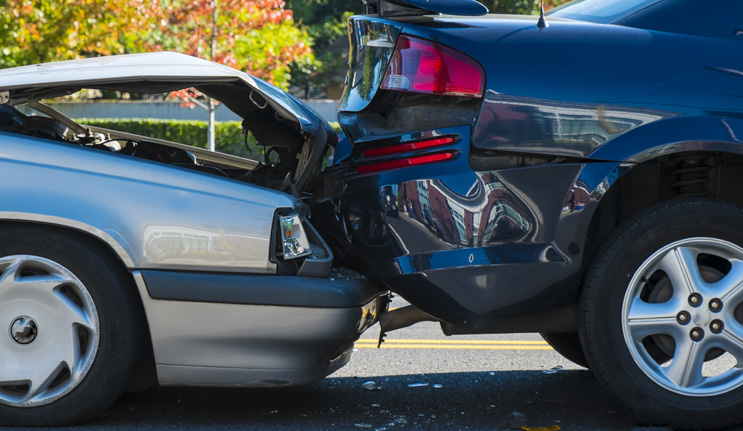You’re taught many things in drivers’ ed, including where to place your hands on the wheel, the rules of the road, and how to parallel park. Driver’s education courses rarely devote much time or effort to teaching you how to specifically avoid collisions like rear-end crashes. This is something you learn over time by gaining driving experience and adapting to local driving styles.
Yet you may not be as prepared to avoid a rear-end collision as you think. This type of crash accounts for about 29% of all accidents, according to the National Highway Traffic Safety Administration (NHTSA). The National Transportation Safety Board (NTSB) reported rear-end collisions accounted for close to half of all two-vehicle collisions between 2012 and 2014.
Given that rear-end collisions occur frequently and can have serious outcomes, it’s important to consider what you can do to avoid these accidents.
Common Causes of Rear-End Collisions
Several factors contribute to rear-end accidents, including:
Distraction
Distracted driving is a major cause of vehicle crashes. Phone use is a common form of distraction. You take your eyes off the road and hands off the wheel to check a text, choose a new playlist, or make a move in a game. That being said, phones are by no means the only form of driver distraction. Rear-end accidents also may be the result of daydreaming, focusing on something outside of the vehicle, reaching for something in the vehicle, or interacting with your passengers. Any type of visual, cognitive, and manual distraction increases the risk of you colliding with the vehicle ahead of you.
Driving Too Closely (Tailgating)
This may be one of the more obvious risk factors for rear-ending another car. When you are too close to another vehicle, it is more difficult to stop suddenly and avoid a crash. As the driver in the back, you may not notice when the vehicle ahead of you starts to slow or suddenly stops. Even if you do notice and brake immediately, there may not be enough distance and time for you to stop without colliding with the other vehicle.
Speeding
Speeding causes similar issues to tailgating. If you are speeding, your vehicle will not stop as quickly. If you fail to notice that the vehicle in front of you is slowing down or stopping suddenly, slamming on your brakes may not be enough to avoid a crash.
Weather
The weather is not to blame for all rear-end collisions, but rain, snow, sleet, ice, and fog can all contribute to an increased risk of crashes. When driving in poor weather conditions, you need to adjust your driving style. You should slow down and leave a greater distance between you and other vehicles. If you fail to adjust for the weather and road conditions, you may not be able to stop in time to avoid a rear-end crash.
Fatigue
An overlooked issue is driving while overly tired. Driving while drowsy can increase the risk of getting into a crash similarly to driving while intoxicated. You are less perceptive, and your reaction time slows down. All of these factors increase your risk of failing to slow down or stop when the vehicle ahead of you does so.
How to Avoid Rear-Ending Another Vehicle
The best way to avoid causing a rear-end crash is adhering to driving best practices:
- Keep a safe distance between you and other vehicles
- Drive the speed limit,
- Avoid distractions
When you fully pay attention to the traffic ahead of you, then you can quickly and appropriately respond when vehicles slow down and stop.
When driving through bad weather, increase the distance between you and other vehicles, reduce your speed, and become even more vigilant about avoiding all distractions.
Keep Your Employees Safe Behind the Wheel with these eLearning Courses:
Avoid Being a Victim of a Rear-End Crash
As a driver, there’s less you can do to avoid being rear-ended. However, there are some steps you can take to reduce the likelihood of being hit from behind. If you notice someone tailgating you, move to the other lane. If you can’t change lanes, and the other driver insists on riding your bumper, consider taking a detour around the block to let that driver get ahead of you. Taking a few minutes out of your day is far less of an inconvenience than being rear-ended.
Avoid slamming on your brakes unless it is an emergency. Brake early and slowly to ensure drivers behind you have plenty of warning that you plan to stop.
No matter what you do as a driver, you may still get into a car accident. But following safe driving habits and being aware of risky situations may help to avoid rear-end accidents.
About the Author

Paul Padda is a personal injury attorney in Las Vegas, NV. Mr. Padda frequently assists clients with car accidents and other personal injury matters. As an experienced injury lawyer, Paul has seen many lives forever changed due to the negligence or carelessness of another driver. As a result of this, Mr. Padda writes about driver safety and other personal injury topics to better educate the public in hopes of reducing the number of accidents on roads across the country.
Keep your drivers safe on the road with these online training courses:
Smartphones and Smarter Driving (Micro Course)



